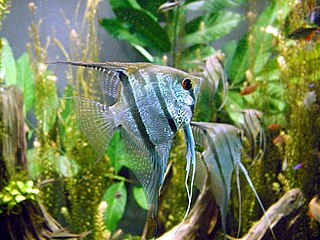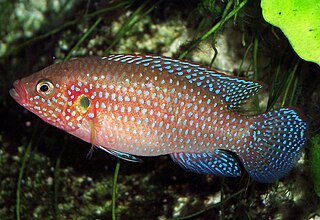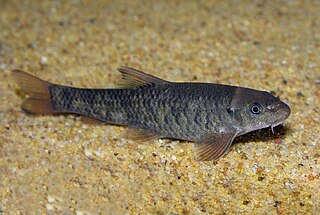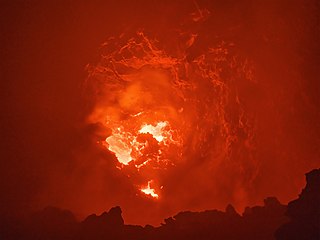
Cichlids are fish from the family Cichlidae in the order Cichliformes. Cichlids were traditionally classed in a suborder, the [Labroidei]], along with the wrasses (Labridae), in the order Perciformes, but molecular studies have contradicted this grouping. The closest living relatives of cichlids are probably the convict blennies, and both families are classified in the 5th edition of Fishes of the World as the two families in the Cichliformes, part of the subseries Ovalentaria. This family is both large and diverse. At least 1,650 species have been scientifically described, making it one of the largest vertebrate families. New species are discovered annually, and many species remain undescribed. The actual number of species is therefore unknown, with estimates varying between 2,000 and 3,000.

Hemichromis is a genus of fishes from the cichlid family, known in the aquarium trade as jewel cichlids. Jewel cichlids are native to Africa. Within West Africa, Hemichromis species are found in creeks, streams, rivers and lakes with a variety of water qualities including brackish water lagoons.

Sarotherodon is a genus of oreochromine cichlids that are native to the northern half of Africa, with a single species, S. galilaeus, also ranging into the Levant. A couple of species from this genus have been introduced far outside their native range, and are important in aquaculture. Most other species have small ranges and some are seriously threatened. They mainly inhabit fresh and brackish water, but a few can live in salt water. Species in this genus, as well as those in several other oreochromine and tilapiine genera, share the common name "tilapia" and historically they were included in the genus Tilapia.

Variabilichromis moorii has no common name and is a species of freshwater cichlid endemic to Lake Tanganyika in eastern Africa. It is a small ovate bodied fish named for an early collector of fish from the lake, John Edmund Sharrock Moore (1870-1947) who was a cytologist, zoologist and led an expedition to Lake Tanganyika and who discovered this species. Juveniles are usually yellow, and adults are dark brown to black in color. It reaches a total length (TL) of 10.3 centimetres (4.1 in). Currently it is the only member of its genus. V. moorii feeds on algae, zooplankton, and benthic invertebrates. It is also found in the aquarium trade.
Dr. Ethelwynn Trewavas was an ichthyologist at the British Museum of Natural History. She was known for her work on the families Cichlidae and Sciaenidae. She worked with Charles Tate Regan, another ichthyologist and taxonomist.

Lamprologus is a genus of fishes from the cichlid family. They are native to Lake Tanganyika and the Congo River Basin in Africa. The type species for this genus is Lamprologus congoensis, a species from the Congo River. The genus is under some revision and may eventually be restricted to these riverine types.

Neolamprologus is a genus of cichlids endemic to eastern Africa with all but one species, Neolamprologus devosi from the Malagarasi River, occurring in Lake Tanganyika. It is the largest genus of cichlids in Lake Tanganyika and also the largest genus in the tribe Lamprologini, which includes Altolamprologus, Chalinochromis, Julidochromis, Lamprologus, Lepidiolamprologus, Telmatochromis and Variabilichromis. The latter is a monotypic genus doubtfully distinct from Neolamprologus.

Lake Afrera is a hypersaline lake in northern Ethiopia. Located in Administrative Zone 2 of the Afar Region, it is one of the lakes of the Danakil Depression. According to its entry in Lakenet, it has a surface area of 100 km2 (39 sq mi), although another source states the area is 125 km2 (48 sq mi). An unconfirmed report gives its depth as 160 m (525 ft); the lake is fed by underground streams.

Garra is a genus of fish in the family Cyprinidae. These fish are one example of the "log suckers", sucker-mouthed barbs and other cyprinids commonly kept in aquaria to keep down algae. The doctor fish of Anatolia and the Middle East belongs in this genus. The majority of the more than 140 species of garras are native to Asia, but about one-fifth of the species are from Africa.

Alcolapia is a genus of small fishes in the family Cichlidae. Their native range is restricted to margins of Lake Natron and Lake Magadi, as well as similar conditions in nearby hot springs, in Kenya and Tanzania. They live in waters that are warm, hypersaline and alkaline. Species from this genus have also been introduced to Lake Nakuru and Lake Elmenteita. They are the only fish in their range.

Paretroplus is a genus of fishes in the cichlid family, all of which are endemic to lakes and rivers of Madagascar. The vast majority are threatened and restricted to the northwestern part of the island. Only P. polyactis is found in the southern half of Madagascar and only P. polyactis and P. gymnopreopercularis are found in eastern drainages. Most are restricted to freshwater, but at least P. polyactis and P. maromandia can also be seen in brackish habitats.

The redbreast tilapia is a species of fish in the family Cichlidae. It is found widely in the southern half of Africa. Its natural habitats are freshwater lakes and freshwater marshes. It is known as the redbreast kurper in South Africa.
Danakilia franchettii is a species of cichlid fish endemic to the saline Lake Afrera and nearby swamps in Ethiopia. It was the only member of the genus Danakilia until the description of D. dinicolai in 2010. The species is listed as endangered, due to water abstraction and mining of salt in the lake. The specific name honours the Italian explorer Raimondo Franchetti (1889-1935), who organised, at his own expense, the expedition that collected type.

Lamprologini is a tribe of African cichlid fishes. It contains seven genera and nearly 100 species. Over half of the species in this tribe are in the large genus Neolamprologus. Most genera in the tribe are endemic to Lake Tanganyika, but one species of Neolamprologus is from the Malagarasi River in Tanzania, and several species of Lamprologus are from the Congo River Basin.
Danakilia dinicolai is a species of cichlid endemic to the saline Lake Abaeded in Eritrea. The specific name honours Ernesto Di Nicola (1969-2001) who was a member of the expedition to Lake Abaeded who died in a car accident while returning from the lake.

The Danakil Depression is the northern part of the Afar Triangle or Afar Depression in Ethiopia, a geological depression that has resulted from the divergence of three tectonic plates in the Horn of Africa.
Melanie Lisa Jane Stiassny is the Axelrod Research Curator of Ichthyology at the American Museum of Natural History. Her research interests focus on freshwater biodiversity documentation and systematic ichthyology in the Old World tropics, including tropical Africa and Madagascar. She has published broadly on the biogeography conservation and systematics of teleosts.

Coptodon is a genus of cichlids native to fresh, brackish and coastal marine waters in Africa with C. zillii also found in the Middle East. It is the only genus in the tribe Coptodonini. Formerly included in Tilapia, this genus and tribe was separated in 2013. Despite the change in genus, Coptodon spp. are still referred to by the common name tilapia. Several species are important in local fisheries and a few are aquacultured.

The redbelly tilapia, also known as the Zille's redbreast tilapia or St. Peter's fish, is a species of fish in the cichlid family. This fish is found widely in fresh and brackish waters in the northern half of Africa and the Middle East. Elsewhere in Africa, Asia, Australia and North America, it has been introduced as a food fish or as a control of aquatic vegetation. Where introduced, it sometimes becomes invasive, threatening the local ecology and species. The redbelly tilapia is an important food fish and sometimes aquacultured.












